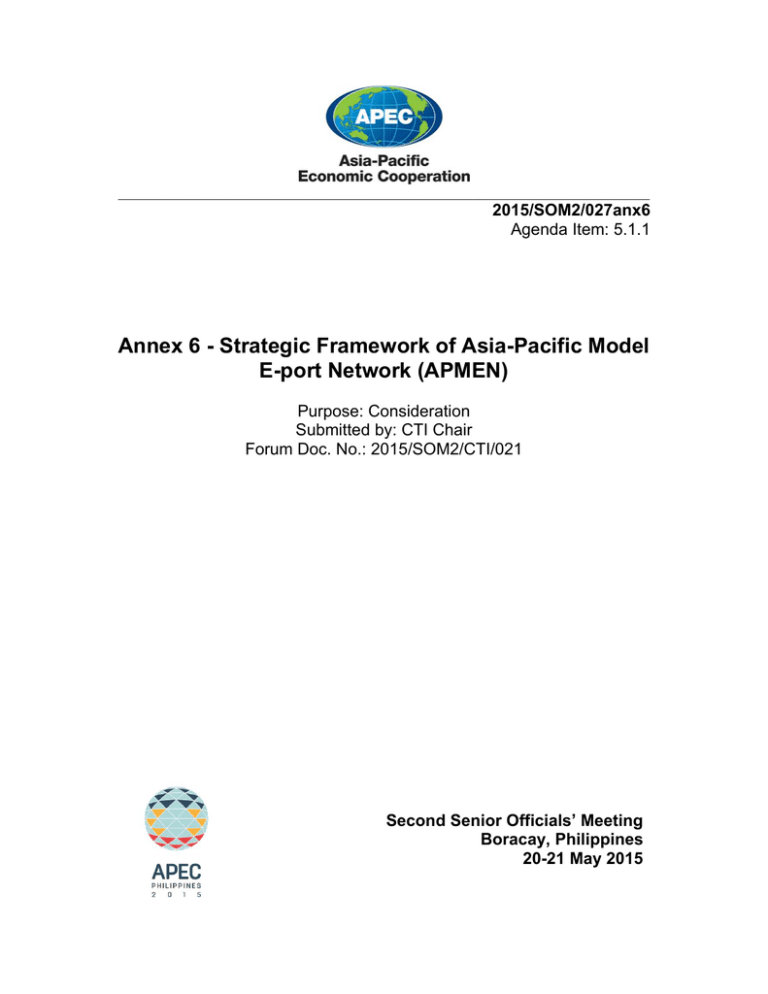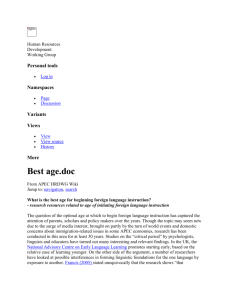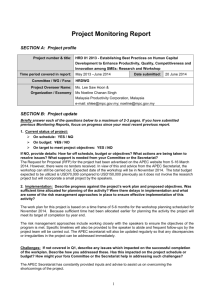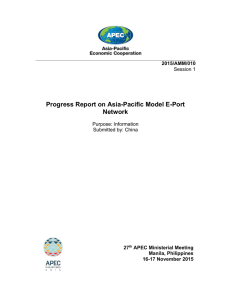Strategic Framework of Asia-Pacific Model E
advertisement

___________________________________________________________________________ 2015/SOM2/027anx6 Agenda Item: 5.1.1 Annex 6 - Strategic Framework of Asia-Pacific Model E-port Network (APMEN) Purpose: Consideration Submitted by: CTI Chair Forum Doc. No.: 2015/SOM2/CTI/021 Second Senior Officials’ Meeting Boracay, Philippines 20-21 May 2015 Strategic Framework of APMEN Background APEC has long recognized the key importance of trade facilitation and supply chain connectivity in achieving free and open trade and investment in the Asia-Pacific. In 2010, APEC leaders committed to “address impediments to moving goods and services through Asia-Pacific supply-chains…with a view to achieving an APEC-wide target of a ten percent improvement in supply-chain performance by 2015”. In 2013, our leaders acknowledged “the importance of addressing unnecessary barriers to trade by advancing regulatory convergence and coherence to achieving our shared objectives of strengthening regional economic integration and ensuring product safety, supply chain integrity”. In 2014, on the 25th anniversary of APEC, our leaders have launched a series of initiatives in the Beijing Agenda targeting at shaping “an integrated, innovative and interconnected Asia-Pacific”, by reaffirming “the role of APEC in addressing next generation of trade and investment issues and sectorial initiatives, and agree to accelerate “at the border” trade liberalization and facilitation efforts, improve business environment “behind the border”, and enhance regional connectivity ‘across the border’ based on global value chain to accumulate more building blocks for the realization of the FTAAP”, including specific instructions for trade facilitation, regional economic integration and supply chain connectivity. Therefore, APMEN may contribute to the realization of all related APEC blueprints and implementation of WTO’s Trade Facilitation Agreement (TFA), as well as the implementation of other related APEC initiatives on supply chain connectivity. Objectives With adherence to the APEC spirit of unity, mutual respect and trust, mutual assistance and win-win cooperation, and on an open and voluntary basis, objectives of APMEN by 2018 are prescribed in the TOR. The following points are complementary to the TOR: 1. Summarize and share the experience of APEC model E-Ports, advance the improvement of Information & Communication Technology (ICT) capability with an aim to promote trade facilitation and supply chain optimization in APEC region. 2. Understand how to advance and extend the practices of model E-ports as well as other similar practices and associated challenges. 3. Identify solutions and enabling environment to enhance transparency of logistics and regulatory issues through data interconnectivity and interoperability, to improve logistics sub-providers capacity, land/air/sea and multi-modes transport efficiency and capabilities in Asia-Pacific region. 4. Compile knowledge on how to enhance coordination among border agencies through public-private partnership (PPP), to simplify customs documentation and other procedures; by 1 more efficient clearance of goods at customs with ICT support, to improve performance of regional cross-border customs-transit arrangements. Actions 1. Realize information sharing on model E-Ports. Hold seminars to raise understanding of E-ports as exploratory solutions to realize goals and targets of Asia-Pacific regional supply chain connectivity, share information, experience in developing, operating and promoting E-Ports. 2. Perform a review of existing literature and work on E-Ports to improve economies’ understanding. 3. Carry out case studies on how economies are using ICT infrastructure in their different types’ cargo hubs for trade facilitation and supply chain performance improvement, including ‘Single Window System’ and ‘One-Stop-Shop Services’ with an aim to help economies understand how their current programs would interface with the E-Port concept 4. Carry out research of solutions to end-to-end supply chain data interconnectivity and interoperability as well as challenges, including: 1) Cross-border public private partnership among all stakeholders across supply chain; 2) End-to-end supply chain data standards, data privacy and security; 3) Lifecycle supply chain data visibility to enable improvement of supply chain performances; 4) End-to-end supply chain regulatory mutual recognition; 5) Third party ICT infrastructural platform for end-to-end supply chain data; 6) Integration with existing E-Ports, ‘Single Window System’ and ‘One-Stop-Shop Services’, with an aim to help members explore how explore application and extension based on the researches. 5. Conduct targeted capacity building activities. In order to help all economies to participate and benefit, targeted and longer term sustainable capacity building projects will be developed and conducted. Private sectors, relevant international institutions and other interested stakeholders will be encouraged to contribute to this process. 6. Explore pilot projects in specific areas of model E-Ports. The optional areas include: 1) production end to consumption end traceability of products; 2) paperless trade; and 3) green freight, logistics and supply chain, etc. 7. Collaborate with other APEC organizations as well as other regional or global organizations. Anticipated Timeline 1. By AELM 2015. 1) Endorse the Strategic Framework, the Work Plan and the Working Mechanism of APMEN; 2) Establish and operate APMEN Joint Operational Group 2 (AJOG), APMEN Operational Center (AOC) and APMEN Experts Pool (AEP); 3) Hold a Public Private Dialogue to enhance the information sharing on model E-Ports among APMEN members; 4) Conduct case studies of existing literature and work and carry out case studies of E-Ports on how economies are using ICT infrastructure in their ports and Single Window programs; 5) Prepare scheme for the first capacity building activity program; 6) Conduct researches on solution to end-to-end supply chain data connectivity and interoperability; 7) Prepare agenda for first batch of pilot projects among model E-Ports; 8) Form collaboration mechanism with other APEC institutions and other regional or global organizations; 9) Submit the report of the second AJOG on APMEN TO CTI3 as well as to report APMEN’s progress in 2015 to Ministers and Leaders. 2. By AELM 2016. 1) Carry out first capacity building activity; 2) Complete review of existing literature and work and complete the case studies of E-Ports; 3) Perform evaluation and start application of the solution to end-to-end supply chain data interconnectivity and interoperability in pilot projects design; 4) Perform mid-term evaluation of first batch of pilot projects of model E-Ports, carry out second batch of pilot projects; 5) Submit a detailed progress report and recommendations to CTI3; 6) Submit a report of the combined case studies to AMM and AELM. 3. By AELM 2017. 1) Carry out second capacity building activity; 2) Perform evaluation of the application of the solution to end-to-end supply chain data interconnectivity and interoperability in the pilot projects and start to extend; 3) Perform final evaluation of first batch of pilot projects of model E-Ports and mid-term evaluation of second batch of pilot projects; 4) Submit a detailed progress report and recommendations to CTI3. 4. By AELM 2018. 1) Perform evaluation on extending application of solution to end-to-end supply chain data interconnectivity and interoperability in the pilot projects; 2) Perform final review of second batch of pilot projects; 3) Review the operations of the APMEN by CTI, determine whether to continue the APMEN, and make any necessary adjustments to its terms of reference and operations. 3




